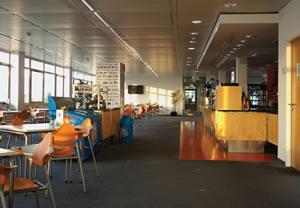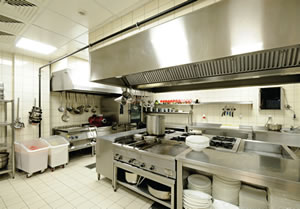Flooring: Putting Your Foot Down

PHOTO © FLICKR/WOLFGANG LONIEN
When it comes to flooring, it’s critical to get it right from the outset. “This ensures you have created a good environment by providing a product that’s strong enough to be walked on every day and has good life cycle costs,” says Vince Haines, AIA, president of PKHLS Architecture in El Dorado, Kan. “To not get it right is disrupting and expensive.” Here’s how the experts get it right.
Spaces and places
On the one hand, there are some spaces where the floor choices are obvious, even when there are other options. For example, Garland Independent School District (GISD) in Texas clads restroom floors in ceramic tile because it’s durable in damp spaces that receive heavy traffic. Cafeterias and clinics are covered in vinyl tile because it’s easy to maintain in spaces where sanitation is important. Offices and libraries feature carpet for sound absorption and aesthetics. Kitchen floors are quarry tile. “In my opinion,” says the district’s coordinator for School Facilities (SFC), who wants to remain nameless, “quarry tile is the only good option. It’s easily repairable, durable, cost effective and has a better track record of staying adhered to the concrete floor. Also, it tolerates minor movement or flexing in the concrete floor without cracking the quarry tile.”
On the other hand, there are spaces where two or three types of flooring work well and the choice is not quite so obvious. At GISD, pre-K and elementary classrooms are outfitted in carpet for floor-time learning with vinyl tile at sinks and work areas. Vinyl tile would work throughout. Middle school and high school classrooms are covered with vinyl tile, which the SFC says is a more cost-effective option. Rolled carpet and carpet tile would work throughout. Administrative areas are similarly covered in vinyl tile because the reception areas in front of the counters are subject to heavy foot traffic. Wood, rolled carpet and carpet tile would work in reception areas. Hallways are covered in vinyl tile. Concrete and carpet tile could be applied to hallways. Entryways are covered in porcelain tile, quarry tile or vinyl tile, although terrazzo is a viable option.

PHOTO © TONY TREMBLAY
Where for Wear? You obviously would not put carpeting in a school restroom or foodservice area. Nor would you expect to find a hardwood floor in a classroom or weight room. When it comes to determining what kind of flooring to put in each area of school, there are many criteria to consider, including first-time costs, life cycle costs, maintainability, acoustics/physical comfort and aesthetics.
The Decision-making process
When it comes to determining what kind of flooring to put in each area of school, there are many criteria to consider, including first-time costs, life cycle costs, maintainability, acoustics/physical comfort and aesthetics.
1. First-time costs: With tight budgets, it’s easy to purchase flooring with strictly first-time costs in mind. But don’t. Do consider all criteria, remembering the time-worn adage, “You get what you pay for.” Here’s how GISD’s SFC weighs in: “Sometimes it gets to be a fine line between choosing vinyl tile or carpet for high school classrooms. We like carpet tile. We’ve been using it for about five years, and it’s becoming more affordable. For us, it’s about economics and, frankly, it costs less to install vinyl tile.”
2. Life cycle costs: This is the total of all costs through the life of the flooring, including first-time, installation, maintenance and other costs. Long-lasting products requiring little maintenance result in low life cycle costs, which are every financial guru’s dream. Count on colleagues, manufacturers and common sense to help you choose flooring with low life cycle costs. GISD’s SFC recalls a time when some adhesives resulted in poor life cycle costs: “Since the early 1980s, when the EPA banned the use of oil-based adhesives, we’ve experienced problems with adhesives holding down carpet and vinyl tile as moisture comes up through the core slab. The adhesive releases, causing tiles to come lose and carpet to buckle. Fortunately, now there are better adhesives available that comply with EPA requirements and withstand moisture, so we’re getting better performance.”
3. Maintainability: Because of flooring’s constant use, maintenance a critical element to consider when making a purchasing decision. Ernie Steinbach, building service supervisor for Lawrence School District in Kansas shares his perspective: “Maintaining flooring properly is one of the most important criteria. It’s one of our biggest issues. Personally speaking, I would prefer not to deal with carpet, because it’s easier to dust mop a classroom than to have to vacuum. We’re going farther and farther away from carpet in hallways, too. The polished and stained concrete look is what we’re moving to.” He acknowledges recently removing 12,000 square yards of carpeting in a second-floor hallway in favor of concrete. “I think at first there was a little bickering about the potential for noise, but we haven’t heard negative feedback since it was removed,” he says.
Haines takes the opposite approach. “We have found when talking with maintenance professionals in the school districts we work with that they prefer carpet in high-traffic areas as there’s no additional cost to keep carpet in good shape,” he says. “And carpet tile in particular offers the ability to remove and replace pieces as necessary when there’s a stain that can’t be cleaned.”
4. Acoustics/physical comfort: Noise is a strong criteria, and it fits hand-in-hand with students’ ages. Soft surfaces, such as carpet, absorb noise and provide comfort for learning that occurs on the floor, which is common in the early elementary grades. “It’s not uncommon for these classrooms to have both hard and soft surfaces to accommodate a variety of teaching conditions,” says Haines. Sound absorption is also a consideration for conference rooms and private offices.
5. Aesthetics: Because schools should be warm and inviting, aesthetics are a consideration in choosing flooring. Haines notes that some of today’s carpet goods are more flexible in terms of design, so his team has greater leeway when it comes to creativity.
Balancing those five criteria can be a real challenge, as GISD’s SFC explains, using vinyl tile as an example. “Vinyl tile has low installation costs, and it’s very, very durable,” he says. “It resists odors and staining. When properly waxed and buffed, it stays clean on a daily basis, which is why we like it for classrooms. There’s some cost involved with keeping it clean and looking good, but that pays off in terms of clean air and staff appreciation.”
Haines similarly discusses balancing the criteria to make a decision: “We steer toward carpet tile for maintainability, acoustics and aesthetics,” he says. “We point toward products that have a longer life. We certainly recommend that there are all kinds of price points in the market for carpet tile, but we don’t steer clients toward the lower end. Sometimes it’s difficult on school budgets, but we explain the life cycle cost and maintenance savings that many carpet goods have. We’re also happy to have carpet manufacturer representatives demonstrate the products we recommend.”
 Those five criteria can be summed up in this term: common sense, as GISD’s SFC indicates: “I think choosing the right flooring for the right place gives you right results for comfort, aesthetics, performance/durability and maintainability. You wouldn’t want to put quarried tile in an office and carpet in a kitchen, for example — not that you would.”
Those five criteria can be summed up in this term: common sense, as GISD’s SFC indicates: “I think choosing the right flooring for the right place gives you right results for comfort, aesthetics, performance/durability and maintainability. You wouldn’t want to put quarried tile in an office and carpet in a kitchen, for example — not that you would.”
Walking on new products
The above criteria is all well and good for established products, but how do you go about applying it to new products? Take Kinetex, for example. It’s an advanced textile composite flooring combining the attributes of soft-surface flooring with the durability and performance characteristics of hard-surface flooring. Its wear layer (composed of abrasion- and ravel-resistant knitted fabric) is thermally fused to a cushioned backing (of polyester felt). Sounds like a great product for classrooms, libraries and offices. But how can you be sure it passes the test before making a purchasing decision? By reading about what tests it has passed, consulting with your entire team and contacting colleagues who’ve already put it to the test.
Kinetex was recommended to Bob Williams, director of Support Services/Buildings & Grounds, at Hutchinson Public Schools in Kansas, by a carpet installer who had installed it in healthcare facilities. With this recommendation, he installed it in the district’s technology support center’s office area to help reduce employees’ allergies and because it has low static electricity discharge.
In the months since the flooring has been in service, Williams has been in close communication with the support center staff, who give it two thumbs up for allergy control (sequesters airborne allergens and irritants and is easily sanitized), and with the custodian responsible for cleaning it, who reports that it’s easy to clean (resists challenging staining agents and is bleach resistant) and is wearing well. As a result, he plans to start using it in upcoming re-carpeting projects.
Similarly, Haines researched Kinetex before recommending it for Circle School District, Towanda, Kan., which is building a 150,000-square-foot school. “It’s a relatively new product, so we had to be convinced of its durability,” he explains. “Based on its rigorous R&D [tested to five million foot traffic events], we were comfortable recommending it. We were especially impressed with how its numbers related to performance and maintenance were better than that of carpet tile.”
There’s a lot to consider in order when choosing the right flooring from the outset. Here’s one more consideration: standardization. It helps when it comes to achieving greater effectiveness in terms of first-time costs, life cycle costs and maintenance. Here’s how Williams puts his foot down: “I believe in standardizing so I don’t have to keep numerous flooring types in stock. Standardizing also helps cut down on costs in terms of equipment and training. The more you can standardize, the better off you are.”
What About Raised Flooring?
Raised flooring, which is ideal for running wiring under the floor rather than in ceilings or walls, has its own set of concerns regarding first time costs, life cycle costs, maintainability, acoustics/physical comfort and aesthetics. Easy installation and reconfiguration, the ability to access/reroute wiring and control static are some of those concerns.
Administrators desiring raised flooring but not having previous experience with it definitely want to consult with colleagues who have experience with it before signing on the dotted line.
The same is true for trying a new product. For example, Avon, Mass.-based SelecTech, Inc., a manufacturer of flooring products from recycled materials, and Ladson, S.C.-based ASM Modular Systems, Inc., a raised access flooring producer, have partnered to develop the Flooring Technology Platform, a raised floor delivering functionality, durability and aesthetics. While new products take time to prove themselves, looking at test results, reviewing the vendor’s reputation and checking out the product warranty are sure to help you make the right flooring choice.
This article originally appeared in the issue of .